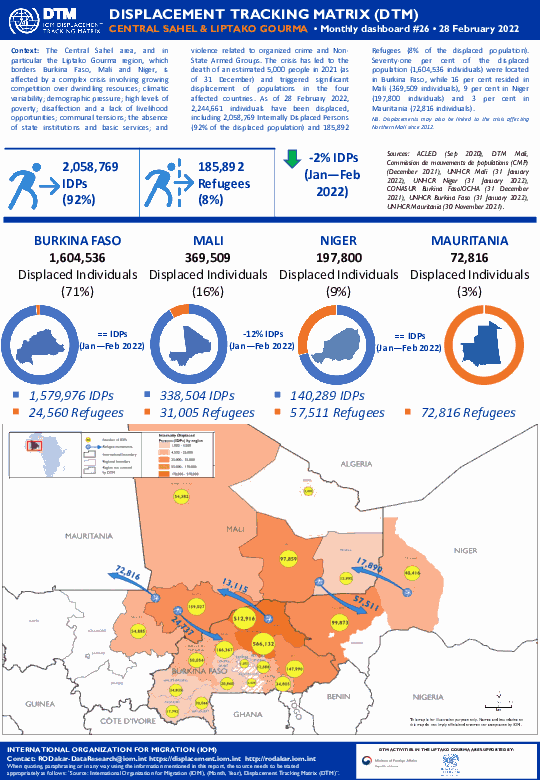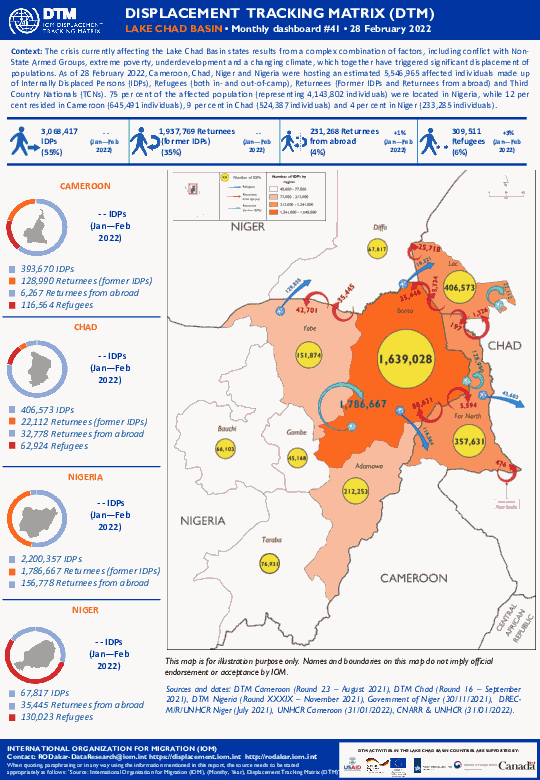-
Countries
-
Data and Analysis
-
Special Focus
-
Crisis Responses
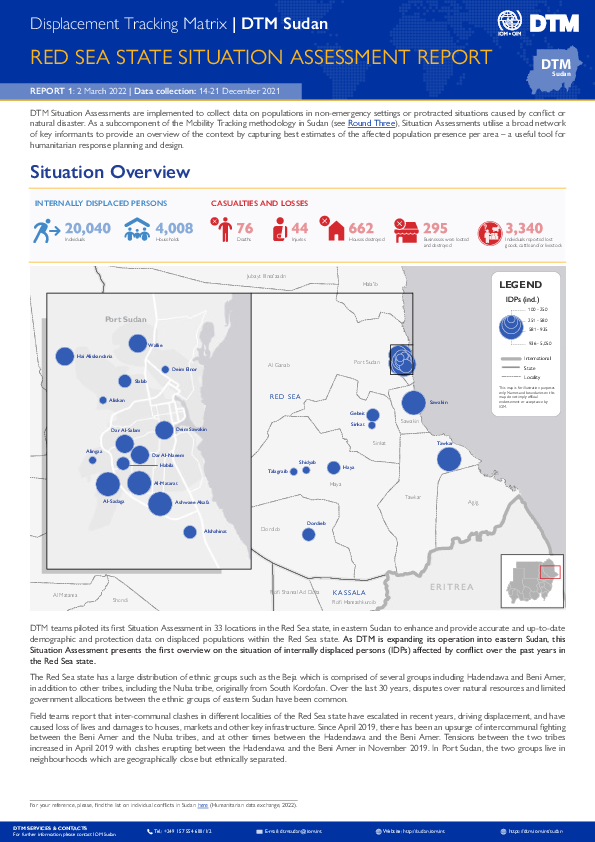
Contact
DTM Sudan; dtmsudan@iom.int
Language
English
Location
Sudan
Period Covered
Dec 14 2021
Dec 21 2021
Activity
- Mobility Tracking
DTM teams piloted its first Situation Assessment in the Red Sea state in 33 locations to enhance and provide accurate and up-to-date demographic and protection data on displaced populations within the Red Sea state. As DTM is expanding its operation into eastern Sudan, this Situation Assessment presents the first overview on the situation of internally displaced persons (IDPs) affected by conflicts in the Red Sea state over the past years.
DTM Situation Assessments are implemented to collect data on populations in non-emergency settings or protracted situations caused by conflict or natural disaster. As a subcomponent of the Mobility Tracking methodology in Sudan (see Round Three), Situation Assessments utilise a broad network of key informants to provide an overview of the context by capturing best estimates of the affected population presence per area – a useful tool for humanitarian response planning and design.
The Central Sahel area, and in particular the Liptako Gourma region, which borders Burkina Faso, Mali and Niger, is affected by a complex crisis involving growing competition over dwindling resources; climatic variability; demographic pressure; high levels of poverty; disaffection and a lack of livelihood opportunities; communal tensions; the absence of state institutions and basic services; and violence related to organized crime and Non-State Armed Groups. The crisis has led to the death of an estimated 5,000 people in 2021 (as of 31 December) and triggered significant displacement of populations in the four affected countries. As of 28 February 2022, 2,244,661 individuals have been displaced, including 2,058,769 Internally Displaced Persons (92% of the displaced population) and 185,892 Refugees (8% of the displaced population). Seventy-one per cent of the displaced population (1,604,536 individuals) were located in Burkina Faso, while 16 per cent resided in Mali (369,509 individuals), 9 per cent in Niger (197,800 individuals) and 3 per cent in Mauritania (72,816 individuals).

Contact
DTM Ethiopia, SLOAddisAbabaDTM@iom.int
Language
English
Location
Ethiopia
Period Covered
Jan 01 2021
Dec 31 2021
Activity
- Site Assessment
- Mobility Tracking
- Village Assessment
The Mobility Overview 2021 report details significant movements within the country and a national overview of displacement and returns, which mainly draws from DTM’s Site Assessment, Emergency Site Assessment, Village Assessment Survey and an extensive national network of key informants.
As of September 2021, displacement was estimated at 4.23 million internally displaced persons (IDPs) throughout Ethiopia. With the outbreak of the Northern Ethiopia Crisis, the Emergency Site Assessment round 8 estimated that there were 2.11 million IDPs displaced due to the Northern Ethiopia Crisis in August 2021 – 1.8 million IDPs displaced in Tigray, 151,040 IDPs in Amhara and 149,329 IDPs in Afar regions. In the second half of 2021, armed conflict moved further down south which resulted in an increase in the number of IDPs in Amhara and Afar regions which is estimated by key informants to have reached around 1.4 million IDPs and 470,000 IDPs respectively at the peak of displacement in early December 2021. Nevertheless, by the end of December 2021, mass returns were taking place in Amhara region. Displacement in the rest of Ethiopia is estimated at 2.12 million IDPs, according to Site Assessment round 27 which took place in August and September 2021. The primary cause of displacement was conflict in 1,160 sites (74%), and the primary reason IDPs were unable to return was that their houses were either damaged or destroyed (1,138 sites, 72%). In addition to conflict, climate induced displacement (droughts, flash floods and seasonal floods) were the primary cause of displacement in 353 sites (22%).
Regarding returns, DTM identified 1.5 million returning IDPs as of Village Assessment Survey round 10 in August and September 2021. A large number of returning IDPs were concentrated in Dawa zone, Somali region and were first identified through round 9 of the Village Assessment Survey when they began to return following the dry season to reconstruct homes that were damaged and in West Guji zone, Oromia region, following the Gedeo-West Guji Crisis in 2018. It is estimated that there have been significant returns in Tigray region as well but this could not be verified in person due to resource constraints and other operational challenges.

Contact
DTM South Sudan, SouthSudanDTM@iom.int
Language
English
Location
South Sudan
Period Covered
Jan 01 2022
Jan 31 2022
Activity
- Site Assessment
- Registration
- Flow Monitoring
- Mobility Tracking
In January 2022, the monthly population count was conducted at Masna Collective Centre where 3,025 individuals / 696 households were identified and Naivasha IDP Camp where 7,885 individuals / 2,146 households were counted. The population of Naivasha IDP Camp increased by 120 compared to December 2021.

Contact
DTM South Sudan, SouthSudanDTM@iom.int
Language
English
Location
South Sudan
Period Covered
Dec 01 2021
Dec 31 2021
Activity
- Site Assessment
- Registration
- Flow Monitoring
- Mobility Tracking
In December 2021, the monthly population count was conducted at Masna Collective Centre where 3,006 individuals / 684 households were identified and Naivasha IDP Camp where 7,765 individuals / 1,981 households were counted. The population of Naivasha IDP Camp decreased by 959 individuals as compared to November 2021.
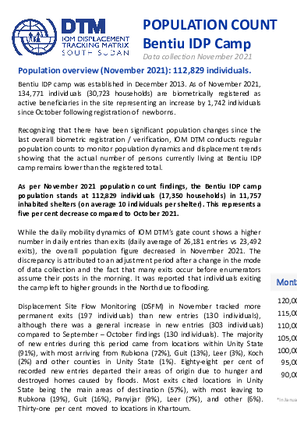
Contact
DTM South Sudan, SouthSudanDTM@iom.int
Language
English
Location
South Sudan
Period Covered
Nov 01 2021
Nov 30 2021
Activity
- Site Assessment
- Registration
- Flow Monitoring
- Mobility Tracking
Bentiu IDP camp was established in December 2013. As of November 2021, 134,771 individuals (30,723 households) are biometrically registered as active beneficiaries in the site representing an increase by 1,742 individuals since October following registration of newborns. Recognizing that there have been significant population changes since the last overall biometric registration / verification, IOM DTM conducts regular population counts to monitor population dynamics and displacement trends showing that the actual number of persons currently living at Bentiu IDP camp remains lower than the registered total.
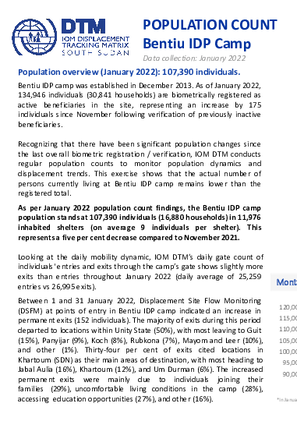
Contact
DTM South Sudan, SouthSudanDTM@iom.int
Language
English
Location
South Sudan
Period Covered
Jan 01 2022
Jan 31 2022
Activity
- Site Assessment
- Registration
- Flow Monitoring
- Mobility Tracking
Bentiu IDP camp was established in December 2013. As of January 2022, 134,946 individuals (30,841 households) are biometrically registered as active beneficiaries in the site, representing an increase by 175 individuals since November following verification of previously inactive beneficiaries. Recognizing that there have been significant population changes since the last overall biometric registration / verification, IOM DTM conducts regular population counts to monitor population dynamics and displacement trends. This exercise shows that the actual number of persons currently living at Bentiu IDP camp remains lower than the registered total.
Contact
DTMAfghanistan@iom.int
Location
Afghanistan
Activity
- Mobility Tracking
- Baseline Assessment
Period Covered
Nov 01 2021 -Dec 31 2021
A baseline assessment is a sub-component of mobility tracking. It aims to collect data on IDP, migrant or returnee population presence in a defined administrative area of the country.
This dataset contains information by settlement. Settlement is the lowest unit of observation used in Afghanistan
Population Groups
Survey Methodology
Unit of Analysis Or Observation
Type of Survey or Assessment
Keywords
Geographical Scope
Administrative boundaries with available data
The current dataset covers the following administrative boundaries
The crisis currently affecting the Lake Chad Basin states results from a complex combination of factors, including conflict with Non-State Armed Groups, extreme poverty, underdevelopment and a changing climate, which together have triggered significant displacement of populations. As of 28 February 2022, Cameroon, Chad, Niger and Nigeria were hosting an estimated 5,546,965 affected individuals made up of Internally Displaced Persons (IDPs), Refugees (both in- and out-of-camp), Returnees (Former IDPs and Returnees from abroad) and Third Country Nationals (TCNs). 75 per cent of the affected population (representing 4,143,802 individuals) were located in Nigeria, while 12 per cent resided in Cameroon (645,491 individuals), 9 per cent in Chad (524,387 individuals) and 4 per cent in Niger (233,285 individuals). The crisis currently affecting the Lake Chad Basin states results from a complex combination of factors, including conflict with Non-State Armed Groups, extreme poverty, underdevelopment and a changing climate, which together have triggered significant displacement of populations. As of 28 February 2022, Cameroon, Chad, Niger and Nigeria were hosting an estimated 5,546,965 affected individuals made up of Internally Displaced Persons (IDPs), Refugees (both in- and out-of-camp), Returnees (Former IDPs and Returnees from abroad) and Third Country Nationals (TCNs). 75 per cent of the affected population (representing 4,143,802 individuals) were located in Nigeria, while 12 per cent resided in Cameroon (645,491 individuals), 9 per cent in Chad (524,387 individuals) and 4 per cent in Niger (233,285 individuals).
Contact
DTMAfghanistan@iom.int
Location
Afghanistan
Activity
- Site Assessment
- Mobility Tracking
Period Covered
Nov 01 2021 -Dec 31 2021
A baseline assessment is a sub-component of mobility tracking. It aims to collect data on IDP, migrant or returnee population presence in a defined administrative area of the country.
This dataset presents a summary at the district level of data collected by DTM in Afghanistan.
Population Groups
Survey Methodology
Unit of Analysis Or Observation
Type of Survey or Assessment
Keywords
Geographical Scope
Administrative boundaries with available data
The current dataset covers the following administrative boundaries
